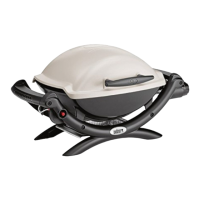WWW.WEBER.COM
®
10
IMPORTANT INFORMATION ABOUT LP GAS
& LP GAS CONNECTIONS
STORAGE AND NON-USE GUIDELINES
For barbecues that have been stored for a while, it is
important to follow these guidelines:
• Do not store a disconnected cartridge/cylinder in a
building, garage, or any other enclosed area.
• Check that the areas under the cookbox and the
removable catch pan are free from debris that might
obstruct the flow of combustion or ventilation air.
• The Weber
®
gas barbecue should be checked for gas
leaks and any obstructions in the burner tubes before
it is used. (Refer to “ANNUAL MAINTENANCE.”)
• The spider/insect screens should also be
checked for any obstructions. (Refer to “ANNUAL
MAINTENANCE.”)
Additional Guidelines for Cartridges
• Disconnect the cylinder if: 1) it is empty; 2) the
barbecue is being stored in a garage or other
enclosed area; 3) the barbecue is being transported.
Additional Guidelines for Cylinders
• The gas must be turned off at the cylinder when the
Weber
®
gas barbecue is not in use.
m WARNING: Make sure that the cylinder
valve is closed when the barbecue is
not in use.
• If storing the Weber
®
gas barbecue indoors, first
DISCONNECT the gas supply and store the cylinder
outdoors in a well-ventilated space.
• If you do not disconnect the cylinder from the Weber
®
gas barbecue, be sure to keep both the barbecue and
the cylinder outdoors in a well-ventilated area.
REGULATOR CONNECTIONS &
REQUIREMENTS
Requirements for Both Cartridges and
Cylinders
• Avoid kinking the hose.
• Change the flexible hose when national regulations
stipulate this as a requirement.
• Any parts sealed by the manufacturer must not be
altered by the user.
• Any modification of the appliance may be dangerous.
Additional Requirements for Cylinders
• In the United Kingdom, this appliance must be fitted
with a regulator complying with BS 3016, having a
nominal output of 37 millibars.
• The length of hose must not exceed 1.5 metres.
• Only a nationally approved low-pressure hose and
regulator must be used.
• Replacement pressure regulators and hose
assemblies must be those specified by the outdoor
cooking gas appliance manufacturer.
WHAT IS LP GAS?
Liquefied petroleum gas, also
called LPG, LP gas, liquid
propane, or simply propane
or butane, is the flammable,
petroleum-based product
used to fuel your barbecue.
It is a gas at moderate
temperatures and pressure
when it is not contained. But
at moderate pressure inside a
container, such as a cartridge
or cylinder, LPG is a liquid.
As pressure is released from
the cartridge or cylinder, the
liquid readily vaporizes and
becomes LP gas.
• LPG has an odour similar to
natural gas. You should be
aware of this odour.
• LPG is heavier than air.
Leaking LP gas may collect
in low areas and resist
dispersion.
2
1
The instructions in this Owner's Guide explain
installation of two possible types of fuel sources:
disposable butane fuel cartridges (1) and larger
refillable propane cylinders (2). The barbecue that
you purchased will use one of these two options.
Follow the specific gas connection instructions that
match your barbecue.
SAFE HANDLING TIPS FOR CARTRIDGES
AND CYLINDERS
There are various guidelines and safety factors that you
need to keep in mind when using liquefied petroleum gas
(LPG). Carefully follow these instructions before using
your Weber
®
gas barbecue.
Tips for Both Cartridges and Cylinders
• Do not use a damaged cartridge/cylinder. A dented
or rusty cartridge/cylinder or a cartridge/cylinder with
a damaged valve may be hazardous and should be
replaced with a new cartridge/cylinder immediately.
• Handle “empty” cartridges/cylinders with the same
care as you handle full cartridges/cylinders. Even
when a cartridge/cylinder is empty of liquid, there may
still be gas pressure inside the cartridge/cylinder.
• Cartridges/cylinders should not be dropped or
handled roughly.
• Never store or transport the cartridge/cylinder where
temperatures can reach 51° C (the cartridge/cylinder
will become too hot to hold by hand). For example: do
not leave the cartridge/cylinder in a car on a hot day.
• Leak-test the joint where the regulator connects to the
cartridge/cylinder each time a reconnection occurs.
For example: test each time the cartridge/cylinder is
reinstalled.
• Cartridges/cylinders must be kept out of reach of
children.
• Do not connect to natural gas supply (city gas).
The valves and orifices are designed exclusively for
liquefied petroleum gas.
• The areas around the cartridge/cylinder must be free
and clear from debris.
• The cartridge/cylinder should not be changed in the
proximity of an ignition source.
Additional Tip for Cartridges
• Always close the regulator gas control valve before
disconnecting regulator.
Additional Tips for Cylinders
• Always close the cylinder valve before disconnecting
regulator.
• Cylinders must be installed, transported, and stored in
an upright position.

